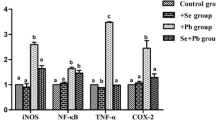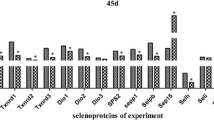Abstract
The interactions between the essential element selenium (Se) and the toxic element lead (Pb) have been reported extensively; however, little is known about the effect of Se on Pb toxicity and the expression pattern of selenoproteins in the cartilage of chicken. To investigate the effects of Se on Pb toxicity and the messenger RNA (mRNA) expressions of selenoproteins in cartilage tissue, an in vitro study was performed on 1-day-old broiler chickens (randomly allocated into four groups) with diet of different concentration of Se and Pb. After 90 days, the meniscus cartilage and sword cartilage tissue were examined for the mRNA levels of 25 selenoprotein genes. The results showed that Se and Pb influenced the expression of selenoprotein genes in the chicken cartilage tissue. In detail, Se could alleviate the downtrend of the expression of Gpx1, Gpx2, Gpx4, Txnrd2, Txnrd3, Dio1, Dio2, Seli, Selu, Sepx1, Selk, Selw, Selo, Selm, Sep15, Sepnn1, Sels, and Selt induced by Pb exposure in the meniscus cartilage. In the sword cartilage, Se alleviated the downtrend of the expression of Gpx2, Gpx3, Gpx4, Txnrd1, Txnrd2, Dio2, Dio3, Seli, Selh, SPS2, Sepx1, Selk, Selw, Selo, Selm, Sep15, Selpb, Sepn1, and Selt induced by Pb exposure. The present study provided some compensated data about the roles of Se against Pb toxicity in the regulation of selenoprotein expression.




Similar content being viewed by others
Reference
Adonaylo VN, Oteiza PI (1999) Lead intoxication: antioxidant defenses and oxidative damage in rat brain. Toxicology 135:77–85
Flora SJ, Pande M, Mehta A (2003) Beneficial effect of combined administration of some naturally occurring antioxidants (vitamins) and thiol chelators in the treatment of chronic lead intoxication. Chem.-Biol. Interact. 145:267–280
Fisher IJ, Pain DJ, Thomas VG (2006) A review of lead poisoning from ammunition sources in terrestrial birds. Biol Conserv 131:421–432
Flora G, Gupta D, Tiwari A (2012) Toxicity of lead: a review with recent updates. Interdiscip Toxicol 5:47–58
Flora SJS (2002) Nutritional components modify metal absorption, toxic response and chelation therapy. J Nut Environ Med 12:53–67
Hartup BK (1996) Rehabilitation of native reptiles and amphibians in DuPage County, Illinois. J Wildl Dis 32:109–112
Gangoso L, Alvarez-Lloret P, Rodriguez-Navarro AA, et al. (2009) Long-term effects of lead poisoning on bone mineralization in vultures exposed to ammunition sources. Environ. Pollut. 157:569–574
Berglund M, Åkesson A, Bjellerup P, Vahter M (2000) Metal–bone interactions. Toxicol. Lett. 112–113:219–225
Nilsson U, Attewell R, Christoffersson JO, et al. (1991) Kinetics of lead in bone and blood after end of occupational exposure. Pharmacol. Toxicol. 68:477–484
Theppeang K, Glass TA, Bandeen-Roche K, et al. (2008) Associations of bone mineral density and lead levels in blood, tibia, and patella in urban-dwelling women. Environ. Health Perspect. 116:784–790
Chariot P, Bignani O (2003) Skeletal muscle disorders associated with selenium deficiency in humans. Muscle Nerve 27:662–668
Zhang JL, Zhang ZW, Shan AS, Xu SW (2014) Effects of dietary selenium deficiency or excess on gene expression of selenoprotein N in chicken muscle tissues. Biol. Trace Elem. Res. 157:234–241
Mariotti M, Ridge PG, Zhang Y, et al. (2012) Composition and evolution of the vertebrate and mammalian selenoproteomes. PLoS One 7:e33066
Liu CP, Fu J, Lin SL, Wang XS, Li S (2014) Effects of dietary selenium deficiency on mRNA levels of twenty-one selenoprotein genes in the liver of layer chicken. Biol. Trace Elem. Res. 159:192–198
Li JL, Ruan HF, Li HX, et al. (2011) Molecular cloning, characterization and mRNA expression analysis of a novel selenoprotein: avian selenoprotein W from chicken. Mol. Biol. Rep. 38:4015–4022
Yao H, Zhao W, Zhao X, et al. (2014) Selenium deficiency mainly influences the gene expressions of antioxidative selenoproteins in chicken muscles. Biol. Trace Elem. Res. 161:318–327
Huang JQ, Li DL, Zhao H, et al. (2011) The selenium deficiency disease exudative diathesis in chicks is associated with downregulation of seven common selenoprotein genes in liver and muscle. J Nutr 141:1605–1610
Cerklewski FL, Forbes RM (1976) Influence of dietary selenium on lead toxicity in the rat. J Nutr 106:778–783
Xu T, Gao X, Liu G (2015) The antagonistic effect of selenium on lead toxicity is related to the ion profile in chicken liver. Biol Trace Elem Res
Deng Z, Fu H, Xiao Y, et al. (2015) Effects of selenium on lead-induced alterations in abeta production and Bcl-2 family proteins. Environ. Toxicol. Pharmacol. 39:221–228
Vengris VE, Maré CJ (1974) Lead poisoning in chickens and the effect of lead on interferon and antibody production. Can J Comp Med 38(3):328–335
Liu C, Fu J, Liu C, Li S (2015) The role of nitric oxide and autophagy in liver injuries induced by selenium deficiency in chickens. RSC Adv. 5:50549–50556
Yao H, Liu W, Zhao W, et al. (2014) Different responses of selenoproteins to the altered expression of selenoprotein W in chicken myoblasts. RSC Adv. 4(109):64032–64042
Yao H-D, Wu Q, Zhang Z-W, et al. (2013) Selenoprotein W serves as an antioxidant in chicken myoblasts. BBA-General Subj 1830(4):3112–3120
Rayman MP (2000) The importance of selenium to human health. Lancet 356:233–241
Burk RF (1991) Molecular biology of selenium with implications for its metabolism. FASEB J 5:2274–2279
Berry MJ, Banu L, Larsen PR (1991) Type I iodothyronine deiodinase is a selenocysteine-containing enzyme. Nature 349:438–440
Xu XM, Carlson BA, Mix H, et al. (2007) Biosynthesis of selenocysteine on its tRNA in eukaryotes. PLoS Biol. 5:e4
Novoselov SV, Kryukov GV, Xu XM, et al. (2007) Selenoprotein H is a nucleolar thioredoxin-like protein with a unique expression pattern. J Biol Chem 282:11960–11968
Zhang JL, Li JL, Huang XD, et al. (2012) Dietary selenium regulation of transcript abundance of selenoprotein N and selenoprotein W in chicken muscle tissues. BioMetals 25:297–307
Guariniello S, Colonna G, Raucci R, et al. (2014) Structure-function relationship and evolutionary history of the human selenoprotein M (SelM) found over-expressed in hepatocellular carcinoma. Biochim. Biophys. Acta 1844:447–456
Malekirad AA, Oryan S, Fani A, et al. (2010) Study on clinical and biochemical toxicity biomarkers in a zinc-lead mine workers. Toxicol Ind Health 26:331–337
Kasperczyk S, Dobrakowski M, Kasperczyk A, Ostalowska A, Birkner E (2013) The administration of N-acetylcysteine reduces oxidative stress and regulates glutathione metabolism in the blood cells of workers exposed to lead. Clin Toxicol 51:480–486
Kasperczyk A, Machnik G, Dobrakowski M, et al. (2012) Gene expression and activity of antioxidant enzymes in the blood cells of workers who were occupationally exposed to lead. Toxicology 301:79–84
Jiang ZH, Khoso PA, Yao HD, et al. (2015) SelW regulates inflammation-related cytokines in response to H2O2 in Se-deficient chicken liver. RSC Adv. 5:37896–37905
Tanekhy M (2015) Lead poisoning in Nile tilapia (Oreochromis niloticus): oxidant and antioxidant relationship. Environ. Monit. Assess. 187:154
Paton ND, Cantor AH, Pescatore AJ, Ford MJ, Smith CA (2002) The effect of dietary selenium source and level on the uptake of selenium by developing chick embryos. Poult. Sci. 81:1548–1554
Sun B, Wang R, Li J, Jiang Z, et al. (2011) Dietary selenium affects selenoprotein W gene expression in the liver of chicken. Biol. Trace Elem. Res. 143(3):1516–1523
Wang R, Sun B, Zhang Z, et al. (2011) Dietary selenium influences pancreatic tissue levels of selenoprotein W in chickens. J. Inorg. Biochem. 105(9):1156–1160
Pawlas N, Dobrakowski M, Kasperczyk A et al (2015) The level of selenium and oxidative stress in workers chronically exposed to lead. Biol Trace Elem Res
Acknowledgments
This work was supported by the China Postdoctoral Science Foundation (No. 2012M520702), Startup Foundation for Doctors of Northeast Agricultural University, China (No. 2012RCB92), the Fundamental Research Funds for the Central Universities (Y0201500195), Heilongjiang Provincial Department of Education Science and Technology research project (No. 12541024), Young Talents Project of Northeast Agricultural University (No. 14QC18), and The International Postdoctoral Exchange Fellowship Program (No. 20130006).
Author information
Authors and Affiliations
Corresponding authors
Additional information
All other authors have read the manuscript and have agreed to submit it in its current form for consideration for publication in the journal.
Rights and permissions
About this article
Cite this article
Gao, H., Liu, C.P., Song, S.Q. et al. Effects of Dietary Selenium Against Lead Toxicity on mRNA Levels of 25 Selenoprotein Genes in the Cartilage Tissue of Broiler Chicken. Biol Trace Elem Res 172, 234–241 (2016). https://doi.org/10.1007/s12011-015-0579-x
Received:
Accepted:
Published:
Issue Date:
DOI: https://doi.org/10.1007/s12011-015-0579-x




